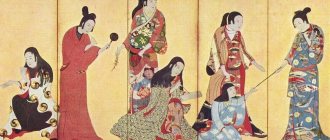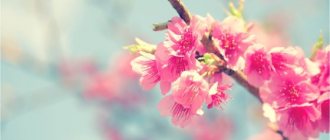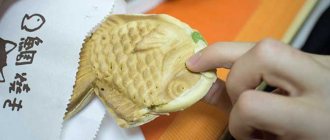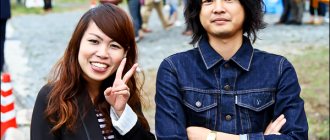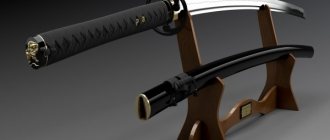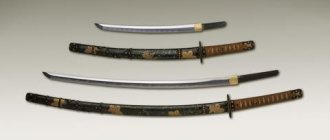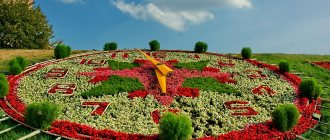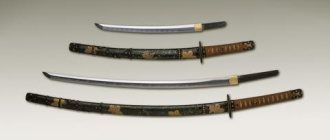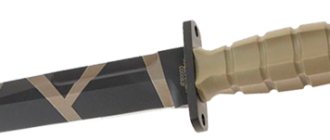History of martial arts kendo
The history of this martial art goes back to the deep past of the Land of the Rising Sun. Japanese samurai are warriors known for their courage and skillful use of weapons. The ability to handle a sword was one of the most significant skills for samurai, because a sword is a symbol of a samurai, his mandatory attribute, the “soul of a warrior.”
From early childhood, the future warrior began to be taught the art of wielding edged weapons. Kendo classes trained strength and tempered the spirit. They were held outdoors in any weather and were intended to prepare the young warrior for battles with combat swords. Skill was determined by the number of sword swings. Ideally, this should be a single fatal stroke, “fast as the flight of a swallow.”
The warriors' training included not only physical exercise, but also breathing training, fortitude, and attention coordination. Meditation, borrowed from Buddhism, was mandatory, which helped to gather and concentrate before the upcoming fight. The main thing for a kendoist is composure and dispassion. Proper breathing is of great importance for a successful fight. It should be smooth and deep, especially at the moment of striking. For this reason, attacking the enemy and striking was accompanied by a loud and sharp cry - it helps to hold your breath for a moment.
In the 16th century, firearms appeared in Japan. In this regard, kendo as a martial art began to lose its role, but its popularity did not weaken. Various schools and techniques began to develop. From the beginning of the 17th century, kendo fighters acquired protective equipment: a helmet, gloves, a breastplate, and the metal fighting sword was replaced by a bamboo sword, which could not cause serious injuries.
The predecessors of Kendo are considered to be three main schools, which borrowed many ideas from the Buddhist movement of Zen:
- Itto-ryu is the “school of one sword”, where priority was given to a single main blow;
- Muto-ryu is training, first of all, the will of a warrior and the teaching that “a sword does not exist from the outside”;
- Munenmuso-Ryu is the “true school of one sword without a blade,” where fencing was taught “without thinking,” reflexively.
In 1868, Kendo was recognized as an official sport in Japan. They began to study it in educational institutions, and special clubs appeared in which the science of Kendo was taught. The first All-Japan Emperor's Cup Championship took place in 1929. However, after Japan's defeat in World War II (in 1945), kendo was banned.
At that time, this sport was considered harmful and inciting Japanese nationalism. The ban lasted until 1950, when the All Japan Kendo Federation appeared. At the present stage, kendo is one of the most popular national sports disciplines in Japan. In addition, kendo became widespread in other countries, including Russia, and in 1970 the International Kendo Federation was created.
Let there be kendo
The samurai strives to offend everyone. In the second half of the nineteenth century, the Meiji restoration began in Japan, and even the last ronin understood: a revolver is strength, a katana is a grave. The sword slowly began to lose its position. Sometimes it even seemed that soon katanas and tantos (samurai daggers) would only be seen on postcards and children's parties.
The sword, which had become unfashionable, was popularized in those years by the Society of Martial Virtues of Greater Japan, which sought to preserve “kenjutsu” - the art of swordsmanship. It was this organization that in 1920 united various schools, courses and clubs “to wield a sword like a samurai” under the single name “kendo” (“the way of the sword”). And the further, the more patriotic-minded youth came to learn to wield a two-handed sword.
Evgeniy Bashin-Razumovsky Expert on historical issues
By the way, the hieroglyph 剣 “ken” does not mean the katana we are used to, but a straight, double-edged, one-handed sword that came from China. Why is that? The Japanese see in the phrase “the way of the sword” rather an archetype of the sword, something like “the father of all swords.” This is the sword that one of the Buddhist protector deities, Fudo Myo-o, is armed with. Using a straight blade, he cuts off delusions and unnecessary thoughts.
A break had to be made only in 1945, when the American government, as a winner, banned this harmful activity - and the “way of the sword” was stopped being taught in schools. But Japan knows how to wait: only eight years have passed, and kendo has been reinstated in the school curriculum.
Philosophy of Kendo
For the martial arts of Kendo, the main thing is a healthy mind, moral strength, and balance. It is these qualities that sensei teachers cultivate in their students. The term “Kendo” is denoted by two hieroglyphs: “ken” - sword and “do” - the path, meaning spiritual improvement. The main thing for a kendoist is to achieve victory over himself, over his fears and shortcomings, to achieve inner peace and balance. It is for this purpose that a kendoist makes his way with a sword in his hands. Ken is a tool of protection, not attack or killing - this is what the philosophy of Kendo says. Its formation was significantly influenced by the Bushido samurai code, which also defines the priorities of justice, spiritual purity, dedication, and honor.
Philosophy and goals of kendo
the spiritual aspect has come to the fore . He considers the true and false goals that a person sets for himself. False goals lead a person to a dead end. If a person wants to establish himself at the expense of others, then this will ultimately turn against him . The sword that a person has places great responsibility on him. He has no right to make mistakes; he cannot correct the mistake later.
The goals of kendo are:
- shaping the mind and body;
- development of the spirit;
- desire for improvement;
- maintaining honor.
Achieving these goals will allow everyone to make a contribution to global goals , which are the well-being of the state and society, as well as contribution to the development of culture, the movement towards peace and prosperity.
Kendo
Equipment
A kendoist's clothing consists of a kendogi - a jacket and pants, and a hakama - wide trousers-skirts in dark blue or white.
Protective equipment (Bogu) includes certain elements. A helmet with a grille protects the head (Men), and the face is protected by hard leather pads (Tsuki-dare). Hands are protected by long and thick fabric gloves - Kote. The protective equipment also includes a bib - Do, and Tare - five vertical stripes of thick fabric covering the waist and groin area. The swordsman's head is wrapped in a cotton towel (Tenugui), which allows the helmet to sit comfortably on the head and absorb sweat.
Sinai - a bamboo sword - consists of four slats made of bamboo or a synthetic material replacing it, fastened with leather fittings. The length and weight of the shinai depend on the characteristics of the fighter. Thus, a children's shinai (for children under 15 years old) has a length of 114 cm and a weight of no more than 400 grams; female – 117 cm and 400 g; male can have up to 120 cm in length and no more than 500 grams of weight. There are also short swords, the length of which is at least 62 cm and weight from 280 grams.
The tsuba (guard) should be round in shape. It is made from genuine leather or artificial material, and has a diameter of no more than 9 cm. The tsuba is attached to the Shinai using a special elastic band - Tsuba-dome.
Rules
All competitions in this sport are held on the basis of the rules established by the International Kendo Federation (IKF), which was created in 1970.
For the fight, “Siaidze” is equipped - a rectangular or square area with sides of 9-11 meters. It is divided into two parts, marked with white and red colors. The center of this territory is indicated by a cross. Competitors wear red or white ribbons (“Mejirusi”) on their backs, corresponding to the side of the court from which they are entering. The judges on the court have a red and white flag in their hands.
There is a one and a half meter free zone around the perimeter. All designating lines are painted with white paint and have a width of 5-10 centimeters.
The panel of judges includes: the chief judge of the competition, the chief judge of the site, the senior judge (he directly controls the course of the entire battle), and the secretary judge. Each match is judged by three judges who record the blows by raising flags of the corresponding color above their heads. Also, during any competition, the presence of doctors is mandatory.
Judging
Kendo is an art in which the athlete with the most points wins. The rating itself is called ippon. A point is given to the athlete for successfully performing a technique and returning to the starting position. A point is given not for the strike itself, but for a series of correctly performed actions. If everything was done in accordance with the rules, then the judge raises the flag and the athlete receives one point. Three judges monitor compliance with the rules. Each of them must have white and red flags in their hands. Ribbons of the same color must be attached to the backs of athletes. After a series of successful actions, the judges raise a flag that matches the color of the athlete’s ribbon. A point is awarded to a fighter if two of the judges raise the flag.
Procedure for admission to competitions
The Competition Regulations spell out all the details that must be taken into account: the qualifications and age of the athletes, the list of documents to be provided and other conditions.
To participate in competitions among boys or girls, a kendoist must be eleven years old. From the age of fifteen, athletes receive the right to participate in senior junior fights, and from the age of eighteen - in adult fights.
Organizations applying for participation submit applications to the organizing committee in accordance with the established form. All participants undergo registration and a medical commission. Also for this sport it is mandatory to insure athletes against accidents during competitions.
Before the start of the competition, all athletes’ personal weapons (“Sinai”) are checked for their suitability for use in fights (“Sinai-check”). If violations are detected, the weapon may not be allowed to compete. Each participant must have a patch on their clothing indicating the name of the fighter (“Nafudu”). It also indicates the club or country for which the competitor competes.
Before the start of the battle, kendoists are put on white or red ribbons, which indicate the area of the site. The admission commission draws up a protocol in which all admitted and not admitted athletes are recorded. If there are disagreements between the team management and the Admission Commission, the decision on admission remains with the Chief Judge of the competition.
Order of the fight
Before the start of the fight, the participants greet each other with a bow, take three steps forward and take a pose of readiness for the fight. The fight begins with the referee's command "Hajime" and ends with his command "Yame".
The fight lasts four to five minutes. All this time, the opponents are throwing piercing or cutting blows with their weapons at each other. To win, you must use the tip of your sword to hit certain spots on your opponent's equipment twice. This could be a mask, gloves or a bib.
The score is kept to three points (this corresponds to the “Sanbon-sebu” rule). However, if the time of the fight has expired and the required number of points has not been scored, victory is awarded to the athlete who received even one point (in accordance with the “Ippon-sebu” rule). The match can be extended for another minute or three (extra time - “Enche”) if during the allotted minutes none of the opponents received at least one point. In this case, the first fighter to receive a point wins. If this does not happen, then the winner is determined by the decision of the judges (Hantei rule) or a draw is awarded (Hikiwake).
The fight may be interrupted if:
- an insult to an opponent or a jury member followed;
- one of the opponents pushed the other, tripped him or deliberately hit unprotected areas of the body;
- one of the athletes lost his weapon;
- the fight becomes dangerous or gets out of control.
If one of the opponents received a blow or a thrust before the “Yame” command, then it is counted.
It is also strictly forbidden to argue with members of the panel of judges. The chief judge may make a remark if the participants in the fight are deliberately stalling for time.
Principles of competitions
There are two competition systems in Kendo:
- Olympic, in which a participant leaves the competition after one or two defeats;
- circular - provides that each participant must meet in battle with all other fighters participating in the competition.
The Regulations and Regulations, which are developed for each competition, specify which system will be used. During the competition, it is mandatory to divide all participating athletes into groups according to age and gender.
It is planned to hold individual and team competitions in categories: boys and girls from 11 to 14 years old, juniors up to 17 years old and adults over 18 years old.
An unofficial team competition will also be held during the competition.
The rules for holding kendo competitions in the Russian Federation are established by the Order of the Russian Ministry of Sports “On approval of the rules of the sport “Kendo”. This Order is based on the rules of the World Kendo Federation, which must be strictly observed by competition participants, coaches, judges and all officials who are involved in the organization and conduct of competitions.
In addition, competitions are held in accordance with the All-Russian Register of Sports and in age categories in accordance with the Unified All-Russian Sports Classification.
Appeals in Kendo
The process of filing protests (“Igi”) and making decisions on them is carried out in accordance with the Regulations developed by the World Kendo Federation (FIK). The decision that the judge makes during the fight cannot be challenged. Exceptions are situations if during the fight the judge does not comply with the guidelines prescribed by the Rules. Such a protest is considered immediately. The igi is carried out by a team representative, who is located in a designated place at the shiai-jo. The representative has a flag that he must raise. He can do this before the end of the battle. In such a case, the decision made by the judge is suspended and the case is reviewed immediately.
Wherein:
- the senior judge suspends the match;
- the panel of judges analyzes the content of the protest during the meeting (“Gogi”);
- after this, the decision of the panel of judges is announced to the team representative who filed the protest;
- At the end of this procedure, the senior referee gives a signal to continue the fight.
If the panel of judges has not reached a consensus or doubts the correctness of its decision, it has the right to involve the chief judge of the competition in making the decision. It may happen that the regulations or the Regulations of the competition are violated. In this case, a petition to solve this problem should be addressed to the chief judge of the competition.
Rank
In Japanese martial arts there is a system of ranks - “Dan”. Dan is a master's degree, in contrast to student ranks - "Kyu".
In kendo, all athletes must be certified; accordingly, they are examined in Kata and knowledge of basic technical actions.
The following evaluation system for examinees has been adopted:
- initial degrees are from 6th to 1st kyu;
- Master degrees - from 1st to 10th dan.
For adults, exams begin from the 4th kyu, and for children - from the 6th.
At least three months must pass between kyu exams. It should be noted that in kendo there are no restrictions on age or other criteria for obtaining dans; the main thing is skill, which is achieved through years of hard training of mind and body.
There are also official honorary titles:
- Ransy is a teacher's assistant. This title is given to masters from 1st to 6th dan;
- kesi – teacher;
- han-si is the highest title. It can be received by a supermaster who has managed to reach 8-10 dan.
The traditions of assigning ranks developed in Japan in ancient times.
According to the Rules established by the Russian Kendo Federation, athletes in this sport receive sports categories from youth (from third to first) to Master of Sports of Russia International class. To receive a rank, a kendoist must participate in official competitions and championships, and at the same time comply with the standards set forth in the Order of the Russian Ministry of Sports.
DOU Hobby: Kendo - Japanese fencing with bamboo swords
[DOU Hobby is a column about non-technical projects of IT specialists: creativity, interesting hobbies and other lifestyle achievements. If you have something to tell us, write to]
Alexander Lipsky - Senior Software Engineering Manager at Lviv EPAM. He is interested in the Japanese martial art of kendo. Alexander told us why he was interested in Japanese fencing, how training is carried out and why you should always listen to what the sensei says.
— Alexander, what is kendo, what are its features? How is it different from other types of fencing?
Kendo is the Japanese art of fencing with bamboo swords. The official year of origin of kendo is considered to be 1920, so it is a fairly young art, although it has its roots in antiquity, in ancient fencing techniques.
Traditional Japanese sword fighting is called kenjutsu - "the art of the sword." Kendo is translated as “the way of the sword”: in this type of fencing, real swords were replaced with bamboo ones and armor was added so that one could not get hurt. The helmet protects the head, the protector protects the body, and special gloves protect the hands. That is, all points where blows are delivered according to the rules are protected.
The idea of kendo is that a person armed with a sword has no right to make a mistake and he has no opportunity to correct it. Accordingly, both in a fight and in everyday life, everything should be taken seriously. Another idea of kendo is that no two situations are the same - each one should be approached with a renewed spirit and fervor, which is something we so lack in modern life.
— How and where did your hobby begin? How many years ago did you first pick up a bamboo sword?
My youngest daughter introduced me to kendo a year ago. She studied at the Budokan School of Oriental Languages and Martial Arts, where instead of traditional physical education they taught aikido, jujutsu and kendo skills. I had heard about kendo before, because I read quite a lot about the history of martial arts, and I practiced them myself, but I had no experience in kendo before. When I bought a shinai (bamboo sword) for my daughter at a martial arts store, I thought: why not try it? And he took the two together and walked more fun, and even encouraged a friend.
— And after the first trial lessons, you continued training. What exactly interested you and attracted you to this sport?
I got involved. I liked the process of training attention and concentration in battle. Wonderful guys, sensei, atmosphere in general.
— How does a typical training go? What is the hardest thing to master?
Warm-up, practicing punches, movements, working in pairs, an hour and a half of fun, at the end - crawling out of the gym. Physically, sometimes it can be a little difficult: out of habit, your arms and shoulders get tired. For example, after practicing strikes for a long time.
A blow in kendo is accompanied by special sounds. Often the battle cry confuses an unprepared spectator, and the athletes themselves do not immediately adapt.
— How often do you train?
I would like to say that regularly, but I don’t want to lie . I try not to miss it, but it doesn’t always work out: busy work schedule, household chores. The average norm for me is two kendo training sessions per week. For those who are preparing for competitions, of course, the schedule is much more intense.
— Does kendo have some kind of philosophical component, like many martial arts? If yes, what is it?
To be honest, I don’t like philosophical discussions. Of course, any art has a philosophy, including martial art. For me, this is an interesting type of martial art, which affects not only physical training, but also personality development: willpower, endurance. As a result, everyone develops a certain philosophy for themselves.
But for beginners, and not only for them, the philosophy is simple: do not skip training and do what the sensei (teacher) requires.
— You mentioned that for fencing, in addition to a sword, you need a helmet, mittens, and a body protector. How much does this equipment cost? How can a beginner choose the right things?
Initial training can be done even in a tracksuit. In the future, you will have to purchase armor, as well as hakama (pants) and kendogi (jacket). By the way, the weight of such armor is 8 kg.
But a shinai (bamboo sword) is needed from the very beginning. You will also need a bokken (wooden sword). It is used to practice kata - formal sequences. All this can be bought in online stores in Ukraine and abroad.
The clothes cost me about 1.5 thousand UAH. I bought the swords during a business trip to New York for $18 apiece. Armor for my daughter - approximately $350. The price fluctuates depending on the quality, so it is better to consult with the sensei.
— What interesting stories do you have related to your hobby? What fights do you remember most?
As I already said, my daughter introduced me to this type of martial art. Most of all, I remember my daughter’s participation in the Kharkov Open Cup, when she, a novice fighter, held her own for several minutes against the leader of the Israeli delegation, without missing a beat. This was a surprise both for the opponent and for our entire Ukrainian group and at the same time a discovery for me: the draw in competitions can put you against a much stronger opponent, and here no one is interested in your little experience, lack of technique, etc. You go forward without room for error - this is the essence of kendo.
— How developed is the kendo community in Ukraine? Are there any clubs or tournaments?
Of course, like any sport, there is a federation and communities. So, there is the Ukrainian Kendo Federation, local and international championships are held. The European Championships took place in Belgrade in May, and the Kharkov Open Cup took place in mid-June. My sensei Natalya Kalinichenko is a member of the Ukrainian kendo team. The son of another colleague, Andrey Arefiev, is also on the team, a multiple champion of Ukraine.
— What physical preparation is needed for this sport? Can anyone pick up a sword and fence, or are there any physical limitations?
Anyone can pick up a sword and train. As for “fencing,” that, of course, will come with time. As for the restrictions, I don’t know, but, in my opinion, if you have hands, you can take up the sword
There are certain rules: we hold the sword with both hands, and the left one actually holds it, and the right one rather guides it. There is no mirroring here. One day, my friend broke his left arm and was out of training for two months.
— In addition to kendo, you have been training in judo, sambo and aikido for more than 8 years - how did this help in learning the Japanese art of fencing?
Judo is judo and kendo is kendo. There is little in common here, except for the general commands in Japanese.
— What skills acquired during sports are useful in your work?
I would say, not in work, but in life... Attention, the ability to make decisions instantly, perseverance. Well, actually wielding a sword - you never know when it might come in handy
Kendo also develops psychological stability - when a man in armor with a raised sword rushes at you, and even screams at the same time (and in kendo a battle cry is required).
— What do you advise to beginners? Where to start, what to pay attention to? How to protect yourself from injuries?
Listen to what the sensei says, without stupid amateur performances. And remember that even a bamboo sword is a weapon. Don’t be afraid to go to seminars or participate in competitions. One of the pitfalls is Japanese terminology; you definitely need to memorize the names right away. And don’t skip training - they are the main engine of progress in technology. No articles or treatises can replace this.
— What sporting goals do you set for the future?
Return to judo and sambo, create a mixed martial arts training schedule and, if possible, not interrupt it - this will be my answer to a sedentary lifestyle
Topics: DOU Hobby, sports
Kendo Federation
The International Kendo Federation (abbreviations: English FIK, Russian IFC) unites national and regional kendo associations, founded in 1970. The main task is to popularize and develop the sport. IFC unites over 50 participants. Every three years, FIK holds the World Kendo Championships.
Since 1974, there has been a European Kendo Federation ( EKF), whose members are almost all national federations of European states. In 1998, the Russian Kendo Federation was registered.
From schoolchildren to police officers
In Japan, kendo is a part of life. A lot of people are involved in it: there is no school or university without a section on the “way of the sword.” True, the attitude towards kendoka (kendo practitioners) is peculiar. In anime, they are most often shown as rude and not the smartest (in one kendo lesson, a fighter receives several hundred sensitive blows to the helmet and head). And because of the sweat absorbed into clothes and armor, the dukhan stands like in the ski section, or even worse.
Therefore, many Japanese women believe that kendo is not very mi-mi-mi. But rather fu-fu-fu.
In Japan, many scientists are studying how the art of fencing affects the health of practitioners - and it seems that the ability to think does not suffer from blows with a shinai. Although from the outside it doesn’t look very nice.
Almost all Japanese police officers polish their sword skills in their free time. It is believed that practicing kendo develops reaction and the ability to act when tenths or even hundredths of seconds are counted.
By the way, most of the winners of the World and Japanese Kendo Championships are Japanese police officers.
Development of Kendo in Russia
The first Japanese fencing competitions in the Soviet Union were held in 1964 at Moscow State University. However, after this, kendo was banned in the USSR for many years. It was believed that it did not correspond to the ideology and principles of the Soviet people. Only in 1989 was the first official organization registered - the Moscow Kendo Club (MCC). Its organizer and leader was MSU teacher V.A. Yanushevsky.
The history of the development of Japanese martial arts in our country begins with this event. In 1990, MKD entered the international kendo community. Cooperation was established with FIK, an international federation. In 1993, the MKD was renamed the Moscow Kendo Association, whose president was N.P. Yakovlev. 1997 - the time of the creation of the Russian Kendo Federation (RFK).
An important event for Russian kendoists was the visit to our country in 1998 by Ryutaryu Hashimoto, the former Prime Minister of Japan and a kendo master. He conducted classes with Russian athletes and presented the “Peaceful Heart” cup. This cup became a challenge award at the Russian Championship in competitions among teams. Currently he is in the Primorsky Regional Kendo Federation. In the same year, the Russian Federation entered the European Kendo Federation and held the Russian Championship for the first time. Since 2008, the RFK became known as the “Russian Federation of Kendo, Iaido, Jodo” (RFKID).
Now Kendo is a popular sport in our country. Championships and competitions are regularly held both at the all-Russian level and at the regional level. Russian athletes also actively take part in international events. The Kendo Federation in Russia includes regional branches from all over the country. In 2013, the Ministry of Sports of the Russian Federation officially recognized kendo and included it in the All-Russian Register of Sports. RFKID is included in the Fencing Federation along with foil and epee fencing. By competing in kendo competitions, athletes receive ranks and titles in fencing. For example, “Master of Sports of Russia in fencing.”
The battle
Chopping blows in kendo - the katana, in fact, is intended for this, with one exception. There is a stabbing blow to the throat called tsuki (pronounced “tski”).
The main thing to remember is that kendo is not really a sport, despite the presence of championships and competitions at all levels. And even during a fight, not every blow counts. To the uninitiated, it seems that the judges who monitor the battlefield are naturally mocking, not taking into account most of the blows.
The thing is that in this art “ki-ken-tai-no-ichi” is extremely important - this is a term denoting the unity of spirit, body and sword. That is, when the fighter pulled himself together and performed a simply epic blow, breaking his opponent in two (just like in the anime). Therefore, it is important not only to strike with a sword - simultaneously hitting the floor with your right foot - but also to indicate the attack with your voice (what kind of voice is it - it should be a guttural scream at the maximum capabilities). At the same time, it is important to demonstrate zanshin - the feeling of a blow: coming out of an attack as if the enemy behind you was defeated without any options.
It all sounds strange, but it looks the same. But only after immersing yourself in the study of kendo, you understand the beauty of this art-sport-philosophy. It is worth remembering: Kendo is least suitable as a self-defense exercise.
Books for learning
At the present stage, quite a lot of books have been published in our country for fans of this sport. From them we highlight:
- "Kendo: The Complete Guide." Author - Hiroshi Ozawa, M., 2000.
This is perhaps the first book in Russian that provides the most detailed information about kendo, including its history, analysis of basic techniques, and necessary equipment. This book will be useful to those who are taking their first steps in kendo.
- “Kendo - the path to courage and nobility”, Savilov V.A., M., 1992.
The author of this publication is the vice-president of the Moscow Kendo Association. He introduces the reader to Japanese martial arts, the basics of its technique and history; dives into the philosophy of kendo. The author conveys to the reader the essence and content of this ancient art of fencing in an accessible form.
- Kendo - the way of the sword", Masatoshi Ichiro, 1993.
This is a methodological manual for the study of oriental martial arts. The book talks not only about kendo, but also about other martial arts.
In conclusion, it should be noted the growing role of martial arts. In the modern world they are becoming increasingly popular. Kendo gives you the opportunity not only to become involved in a unique sport, but also to immerse yourself in the mystery of ancient Japanese history and philosophy. The Japanese treat this type of martial arts with great respect and reverence and hope that in the future kendo will be included in the program of the Olympic Games.
